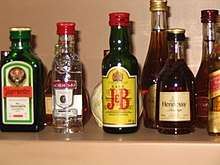Campari
|
| |
| Type | Bitters |
|---|---|
| Manufacturer | Campari Group |
| Country of origin | Italy |
| Alcohol by volume | 20.5–28% |
| Proof (US) | 56 |
| Colour | Carmine |
| Flavour | Bitter, spicy and sweet |
| Website |
campari |
Campari is an alcoholic liqueur, considered an apéritif (20.5%, 21%, 24%, 25%, or 28.5% ABV, depending on the country in which it is sold), obtained from the infusion of herbs and fruit (including chinotto and cascarilla) in alcohol and water. It is a bitters, characterised by its dark red colour.
Campari is often used in cocktails and is commonly served with soda water or citrus juice, or with prosecco as a spritz. It is produced by the Davide Campari Group, a multi-national company based in Italy.
History
Campari was invented in 1860 by Gaspare Campari in Novara, Italy. It was originally coloured with carmine dye, derived from crushed cochineal insects, which gave the drink its distinctive red colour.[1]
In 1904, Campari's first production plant was opened in Sesto San Giovanni, near Milan, Italy. Under the direction of Davide Campari, Gaspare's son, the company began to export the beverage, first to Nice in the heart of the French Riviera, then overseas. The Campari brand is now distributed in over 190 countries.
In the Italian market, Campari mixed with soda water is sold in individual bottles as Campari Soda (10% alcohol by volume). Campari Soda is packaged in a distinctive bottle that was designed by Fortunato Depero in 1932.
Campari is an essential ingredient in the classic Negroni cocktail, the Garibaldi cocktail, the Americano (which was named at a time when few Americans were aware of Campari), and the spritz (an aperitif popular in northern Italy).
Awards
Wine Enthusiast has reviewed Campari on a number of occasions, most recently giving it a score of "96–100" in 2011.[2] Proof66 rates Campari in the Top 10 percentile of liqueurs in the world.[2]
See also
References
- ↑ "Campari changes carmine to artificial color?". Chowhound. June 1, 2007. Retrieved 11 July 2018.
- 1 2 Campari Page on Proof66.com
External links
| Wikimedia Commons has media related to Campari. |
- Campari website
- "Campari: the Italian classic that still has style", The Daily Telegraph
- Chapter 9: "Campari: product diversification and international expansion", Corporate Strategy and Firm Growth: Creating Value for Shareholders, by Angelo Dringoli
- The Art of Campari


